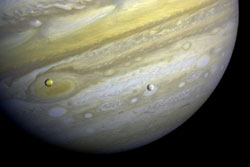
In this close-up view from the Voyager 1 spacecraft on February 13, 1979, Jupiter’s moon Io hovers above the planet’s Great Red Spot while Europa hangs in the foreground to its right. It seems that these two, and the other Galilean satellites, took more than 100,000 years to form.
Courtesy NASA / JPL.
Jupiter and its moons have long been likened to a miniature solar system — a gas-rich giant surrounded by a retinue of satellites that display remarkable diversity. But it seems that the moons of this system-within-a-system may have formed very differently than the planets did.
Theory states that the planets accreted from a gassy protoplanetary disk orbiting the infant Sun. But if Jupiter’s moons formed the same way, several paradoxes must be resolved. For example, under this gas-rich scenario, the four Galilean moons should have assembled from the existing disk of dust and gases very quickly, within 1,000 years. Such rapid formation would generate tremendous heat, around 1,000° Kelvin, baking the moons so completely that they would have differentiated into distinct layers.
However, Jupiter’s large outer moon Callisto contains a great deal of ice and is a mostly homogeneous mix of rock and ice throughout. Thus it must have remained cool as it formed — suggesting a slow and less violent gestation of 100,000 years or longer. Icy Ganymede also has problems with a gas-rich origin. The disk would have been too hot for ices to have condensed and been incorporated into the satellite.
To solve these problems, Robin M. Canup and William R. Ward (Southwest Research Institute, Colorado) have proposed a new model — a gas-starved scenario — in the December 2002 issue of the Astronomical Journal. They suggest that the Galilean satellites came together only near the end of Jupiter’s growth phase. "Imagine a time when Jupiter is almost full size," says Canup. "There was still nebular gas" in the protoplanetary disk that was becoming the solar system, "but a gap in the nebula had already been formed by Jupiter." Some of the lingering gas and small particles outside the gap slowly trickled into Jovian orbit. Once there, they formed a much smaller, more tenuous disk that provided the material for moon formation.
Canup and Ward estimate that for nearly 100,000 years, 2x10-7 Jovian mass of material entered the system every year. The total equals the mass assumed to exist all at once in the gas-rich model. The dribbling infall collided with any existing Jovian-system gas and decelerated before eventually going into moon formation. The astronomers’ simulations suggest that while most of the entering gas spread onto the planet, the entering solids efficiently accumulated into satellites.
In a gas-starved environment, the disk never gets warm enough to prevent ice condensation at the distance of Ganymede. And there is plenty of time for Callisto to form slowly and be nearly homogeneous.
A remaining question is why Ganymede — which also would have formed slowly — differentiated while Callisto did not. Several possibilities exist. The first is that the moon underwent a large collision after its formation that heated and separated the object into distinct layers. Or maybe Callisto and Ganymede straddle the fine line between a body that tends to differentiate and one that doesn’t. Ganymede, being a bit larger and located a bit closer to Jupiter, might have been more apt to split into layers than its sister moon. Another possibility has to do with orbital resonances. Io, Europa, and Ganymede are currently orbitally locked together, with Callisto the outcast. Perhaps earlier tugging by its inner siblings, along with tidal heating by Jupiter itself, caused Ganymede to heat up enough to push it past the differentiation heat threshold.
 0
0
Comments
You must be logged in to post a comment.